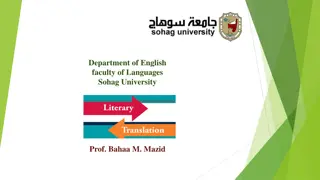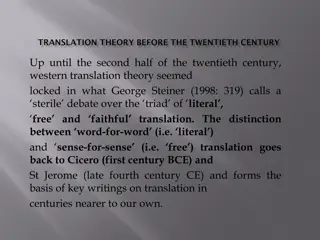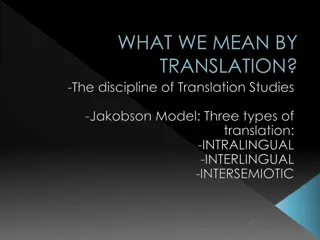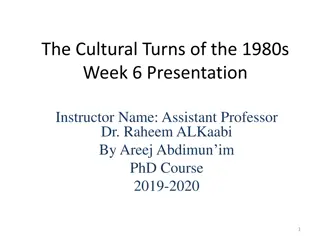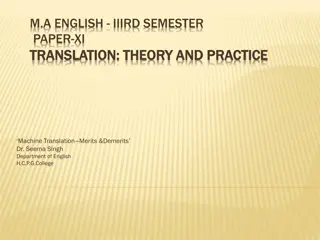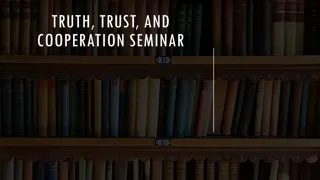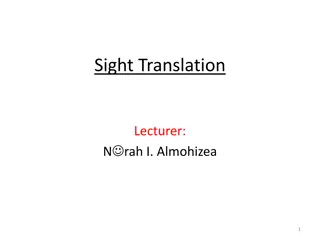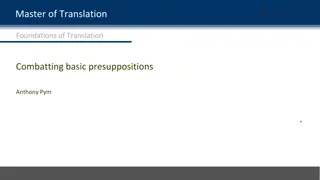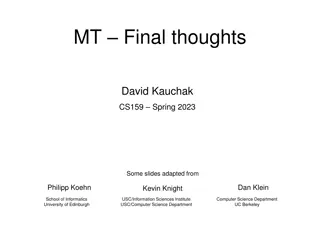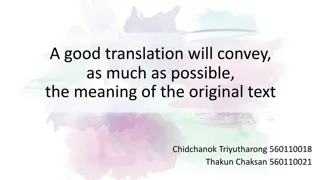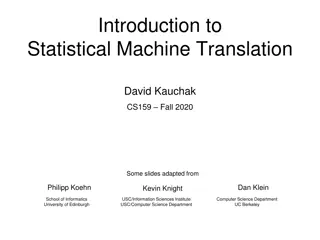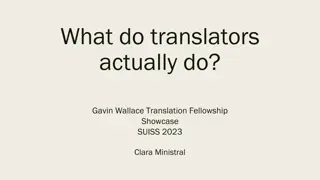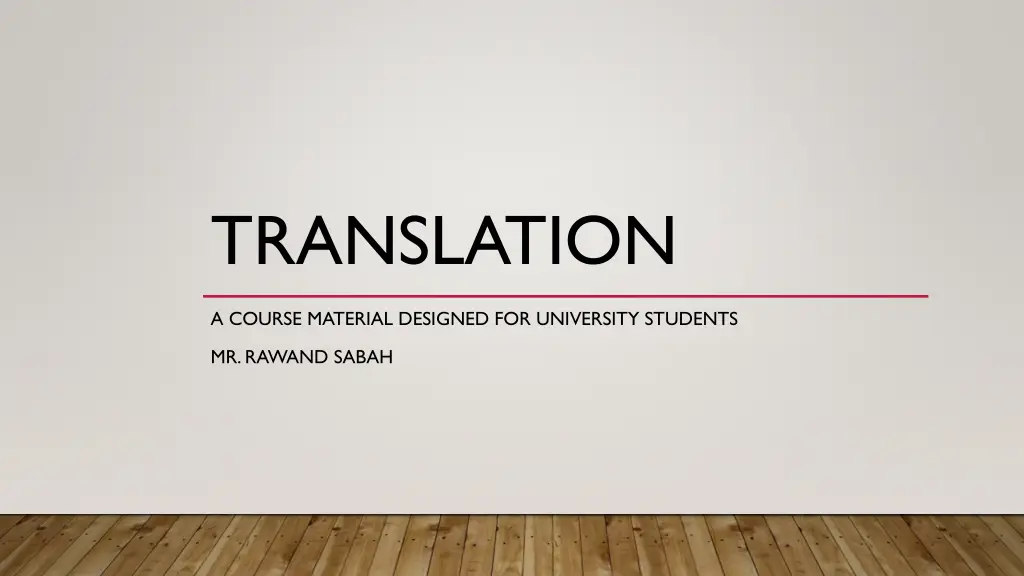
Translation in University Course Material by Mr. Rawand Sabah
Explore the comprehensive course material on translation designed for university students by Mr. Rawand Sabah. Understand the essence of translation, its goals, procedures, strategies, and methods as elucidated in the content, accompanied by insightful perspectives by renowned scholars like Roger T. Bell and Krings. Delve into the art of transferring meaning from source to receptor languages while maintaining idiomatic essence.
Download Presentation

Please find below an Image/Link to download the presentation.
The content on the website is provided AS IS for your information and personal use only. It may not be sold, licensed, or shared on other websites without obtaining consent from the author. If you encounter any issues during the download, it is possible that the publisher has removed the file from their server.
You are allowed to download the files provided on this website for personal or commercial use, subject to the condition that they are used lawfully. All files are the property of their respective owners.
The content on the website is provided AS IS for your information and personal use only. It may not be sold, licensed, or shared on other websites without obtaining consent from the author.
E N D
Presentation Transcript
TRANSLATION A COURSE MATERIAL DESIGNED FOR UNIVERSITY STUDENTS MR. RAWAND SABAH
WHAT IS TRANSLATION? a. Translation consists of transferring the meaning of the source language text into the receptor language text.
WHAT IS TRANSLATION? b. Roger T. Bell (1965: 6) Translation is the replacement of textual material in one language by equivalent textual material in another language.
WHAT IS TRANSLATION? C. Translating consists of reproducing in the receptor language the closest natural equivalent of the source language message, first in terms of meaning and secondly in terms of style
WHAT IS TRANSLATION Translation consists of transferring the meaning of the source language text into the receptor language text. What is the goal of a translator? The goal of a translator should be to produce a receptor language text (translation), which is idiomatic; that is, one which has the same meaning as the source language but is expressed in the natural form of the receptor language. The meaning, not the form, is retained.
Translation procedures, strategies and methods The translating procedures, as depicted by Nida (1964) are as follow: I. Technical procedures: A. analysis of the source and target languages; B. a through study of the source language text before making attempts translate it; C. Making judgments of the semantic and syntactic approximations. (pp. 241-45) II. Organizational procedures: constant reevaluation of the attempt made; contrasting it with the existing available translations of the same text done by other translators, and checking the text's communicative effectiveness by asking the target language readers to evaluate its accuracy and effectiveness and studying their reactions (pp. 246-47).
Krings (1986:18) defines translation strategy as "translator's potentially conscious plans for solving concrete translation problems in the framework of a concrete translation task," and Seguinot (1989) believes that there are at least three global strategies employed by the translators:(i) translating without interruption for as long as possible;(ii) correcting surface errors immediately; (iii) leaving the monitoring for qualitative or stylistic errors in the text to the revision stage.
Newmark (1988b) mentions the difference between translation methods and translation procedures. He writes that, "[w]hile translation methods relate to whole texts, translation procedures are used for sentences and the smaller units of language" (p.81). He goes on to refer to the following methods of translation: Word-for-word translation: in which the SL word order is preserved and the words translated singly by their most common meanings, out of context. Literal translation: in which the SL grammatical constructions are converted to their nearest TL equivalents, but the lexical words are again translated singly, out of context. Faithful translation: it attempts to produce the precise contextual meaning of the original within the constraints of the TL grammatical structures. Semantic translation: which differs from 'faithful translation' only in as far as it must take more account of the aesthetic value of the SL text.
Adaptation: which is the freest form of translation, and is used mainly for plays (comedies) and poetry; the themes, characters, plots are usually preserved, the SL culture is converted to the TL culture and the text is rewritten. Free translation: it produces the TL text without the style, form, or content of the original. Idiomatic translation: it reproduces the 'message' of the original but tends to distort nuances of meaning by preferring colloquialisms and idioms where these do not exist in the original. Communicative translation: it attempts to render the exact contextual meaning of the original in such a way that both content and language are readily acceptable and comprehensible to the readership (1988b: 45-47). Newmark (1991:10- 12) writes of a continuum existing between "semantic and "communicative" translation. Any translation can be "more, or less semantic more, or less, communicative even a particular section or sentence can be treated more communicatively or less semantically." Both seek an "equivalent effect." Zhongying (1994: 97), who prefers literal translation to free translation, writes that, "[i]n China, it is agreed by many that one should translate literally, if possible, or appeal to free translation."
ESTABLISHING THE PROJECT 1-The Text Feasibility, Desirability, Who read, effect on audience, is there money available, who will publish it, texts are be translated for various reasons( historical, political, religious, travelogue,
2-The Target Audience Who will use it? Age, education level,dialect, social level, purpose
3-The translation team A project will involve a number of people: they must be able to read , write, and speak source language, may in need of some one as a adviser, consultant, proofreaders, keyboarders, reviewers, publisher,
4-tools Books, equipement (typewriter, computer, rinnter,duplicator,photocopy machine), workspace, finances, dictionaries, lexicons, grammars, cultural discriptions etc..
RECALL OF PROCEDURES OF TRANSLATION 1-Beyond the Dictionary 2-The Importance of Context
Another crucial thing to remember while translating is context. The context will determine the meaning of a word. When you look up for a word in the dictionary, you may find many equivalents or synonyms. It is now left for you to choose the appropriate or correct equivalent. It is the context that will tell you which word or expression is appropriate. Take for instance, the following sentences: The man kicked the bucket yesterday. He is going to beburied today. From the context, it is clear that the man did not physicallykick the bucket in the sense of using his leg to strike a bucket. Thesecond sentence which talks about burial gives you the clue to the contextual meaning. It means the man died . In fact to kick the bucket is an idiomatic expression meaning to die .
3- Creativity and Adaptation The translator should be creative too. This will be necessaryas you come expressions that you word foradaptation is accommodation. or accommodation: cultural, political, religious, 4- Beyond Bilingualism across words and cannot translate literally. You have learnt of adaptation. Another There are different types ofadaptation Bilingualism involves two languages. Someone who is bilingual is able to speak or write two languages. We have seen that it is not enough to be bilingual in order to translate. Language involves elements of culture. You cannot understand some aspects of a language if you do not understand the culture of the people. For this reason, a translator should, ideally, be bicultural too. That means the person should have a good knowledge of the two cultures in question.
STEPS IN TRANSLATION PROCESS According to Ronald H. Bathgate ( noitalsnart ssecorp : 1.Tuning 2.Analysis 3.Understanding 4.Terminology 5.Restructuring 6.Checking 7.Discussion ereht era taht setats ( 1983 ni spets neves
Next, comprehension. In this step, translators try to catch the overall meaning of the text and be equipped with his vast knowledge of the text. Next, appropriate terms for the transfer from Source L anguage to Target Language effort to find equivalent and na : ygolonimret Next make new structure in TL after the SL text has been splitted structurally clauses, pharases and words. . In this step, translators try to tgnirutcurtser , and semantically into
Checking check the final draft and then consult it to experts or editor, etc. means proofreading. Translators Then, experts or editors, then it goes to the last step. In this step, the final draft in Target Language is ready to be published and critsized by public. discussion. After having review from
According to Nida (1974) There are three steps of translation process: (1) Analysis (2) transferring (3) restructuring
Translating short stories can be a challenging but rewarding task. Here are some steps you can follow to help you translate a short story: Read the original story thoroughly: Before starting the translation process, it's essential to understand the original story completely. Read it several times to make sure you understand the plot, characters, and themes.
Make a rough translation: Start with a rough translation of the story. Don't worry about getting it perfect at this stage, just aim to get the general meaning across. Use a dictionary and other resources to help you with difficult words and phrases
Revise the rough translation: Once you have a rough translation, revise it to ensure that it's accurate and flows well in the target language. Make sure that you have captured the meaning of the original story while also ensuring that the translated text reads well and makes sense in the target language.
Pay attention to style and tone: When translating a short story, it's essential to capture the author's style and tone. This means paying attention to the author's choice of words, sentence structure, and literary devices. Try to replicate the author's style and tone as closely as possible
Get feedback: Once you have completed the translation, ask for feedback from someone who is fluent in both languages. This will help you identify any errors or areas that need improvement.
Proofread: Once you have incorporated the feedback, proofread the translation carefully. Look for errors in grammar, punctuation, and spelling. You may want to use an online grammar checker or proofreading tool to help you with this.
Edit as needed: Finally, make any necessary edits to the translation to ensure that it's the best it can be. Once you're happy with the final version, you can share the translated story with others
PROBLEMS OF ENGLISH-KURDISH TRANSLATION Cultural Problems of English Kurdish Translation The cultural factor in translation is indisputable as no meaningful communication can take place unless the message transmitted through texts is well understood by the communicants. People belonging to the same linguistic community are members of one culture. They share in common many traditions, habits, and ways of life.
Researchers have observed that general problems of translation include lack of exact equivalent in the target language due to cultural difference, semantic differentiation, grammatical structure, dearth of vocabulary etc. Isabel Alousque, while explaining the implication of cultural domains for translation observes that: Words encoding cultural information are difficult to translate since they involve cultural knowledge and a cultural background. Literal translation may not fully render the meaning of culture bound words because they do not have the same semantic range in the source and the target languages .
These cultural problems could be divided into political, social, religious, material and ecological (Nida1964). There are differences between Western and Kurdish cultures, which may cause problem in English - Kurdish translation. Therefore, finding translation equivalents for cultural terms would require bridging the cultural gaps between English and Kurdish cultures so as to meet readers' expectations.
Linguistic Problems of English Kurdish Translation It is particularly necessary for English Kurdish translators to be conscious of the differences between English and Kurdish linguistic systems, as differences between the two systems may cause problems in translation, and affect the quality of the Kurdish translation (i.e. the Kurdish output). Studies have identified morphology and syntax (such as adjectives, adverbials, prepositions, conjunctions etc) as some of the areas of linguistic problems in English Kurdish translation because both languages differ in morphological and syntactic systems.
Unlike Kurdish, some English words may belong to more than one word class such as "fire", which can be both a noun and a verb. On the other hand, some grammatical features which are expressed by morphology in Kurdish such as passivation are expressed in English by syntactic features. One word in Kurdish can frequently be a complete sentence in English. For example, the Kurdish word ( )"I know him" contains the verb, the subject and the object
Written Translation Written translation is the translation you see on paper. It is the translation you write. This type better known as interpretation.The similarities and differences will be highlighted as the unit expands. that differs from oral translation, which is
Oral Translation or Interpretation In oral translation , the words are spoken, not written. This type of translation is called interpretation. The person who does oral translation is called an interpreter.
TYPES OF INTRPRETATIONS 1- Simultaneous Interpretation As the name suggests, in simultaneous interpretation, the speaker or orator and the interpreter speak almost at the same time. As the speaker is talking, the interpreter tries to produce the target language message immediately. In modern times, simultaneous interpretation started in Nuremberg in 1945/1946 when interpreters did their work in cabins. In advanced countries like America, Britain and France, simultaneous interpretation is a very serious business. It requires highly skilled people. Interpreters generally stay in a booth where they can work undisturbed. They work on the message, bit by bit, as the speaker goes on, for the benefit of those who need to wear a headphone to understand.
2-Consecutive Interpretation In consecutive interpretation, the interpreter waits for the speaker to finish before he or she starts interpreting. The interpreter starts after a good chunk of the message is given or waits till the end of the whole message. The waiting interval could range from one to fifteen or even thirty minutes. In some very formal situations, the speaker is obliged to stop at specific intervals to allow the interpreter to do his/her work. This is to avoid a situation where the speaker or orator may be carried away and speak for too long. He or she normally writes down salient or important points or aid memory.
3- Whispered Interpretation In this case, the interpreter sits by someone who does not understand the language of the speaker. He or she then whispers into the ear of the person who requires interpretation. This is done without gadgets like headphone or microphone. In French, we call this activity le chuchotage. The interpreter may interpret for more than one person. Le chuchotage is midway between simultaneous interpretation and consecutive interpretation.
PHASES OF INTERPRETATION The term interpretation is derived from Latin. It can be divided into three main phases: i) The listening phase. The interpreter listens attentively to the orator. He then reproduces the same message in a language that is different from that of the orator. The target language (TL) is that of the audience. ii) The comprehension phase. The interpreter has to assimilate or properly understand the message. He cannot interpret what he does not understand. He has to understand the message correctly. A wrong understanding naturally leads to a wrong message. iii)The re-expression phase. reproduced faithfully, precisely and completely. The message is
DIFFERENCES BETWEEN TRANSLATION AND INTERPRETATION. distinguish it from interpretation. Some of the differences are as follows: 1. The translator may not see the author. 2. The work to be translated is in written form. 3. In almost all cases, the original work and the translation are produced at different times. On the other hand, the interpreter sees the speaker. He is present while the speaker is delivering his message. What is to be interpreted may not be written. It may be spoken in the original form and it is also interpreted orally. The translator has time to consult dictionaries and other documents in the course of his work. The interpreters cannot consult while talking. He can only do so after the work. When you use the word translation to mean solely what is written, you can
Types of Competences Required for being a Professional Translator
1. LINGUISTIC COMPETENCE This grammar encompasses a finite system of principles and set of rules on phonology, syntax and morphology. However, The Translator is more than an ordinary language user. The translator as a special user of languages may find this knowledge of a limited set of rules governing the language not sufficient to translate. He may require additional knowledge which might enable him to understand the characteristics of the language involved and might provide him with adequate linguistic means to accomplish his task.
2. COMPREHENSION COMPETENCE Comprehension competence is the ability to analyse a text semantically and pragmatically. The translator must be able to extract information from the text, understand and interpret it. However, much of the information required in understanding a text is drawn from the language user s general knowledge. As Van Dijk and Kintsh (1983,42) put it: " During comprehension readers pull out from their general store of knowledge some particular packet of knowledge and use it to provide a framework for the text they are reading". This store of knowledge is embodied in the translator's encyclopedic knowledge.
3. ENCYCLOPEDIC COMPETENCE By encyclopedic competence we do not mean that the translator should know absolutely everything about anything. However, due to the variety of subject matters with which the translator is confronted, a certain encyclopedic knowledge ( or 'culture generale' ) is needed. When dealing with a specific text, for instance a literary text, the translator has to acquaint himself with the cultural, political, and historical aspects of the text if there are any. That is, in short, he must have backgound knowledge concerning the text he sets to translate. The translator of Joseph Conrad's novel 'Heart of Darkness', for example, would need to be familiar with all the facets of Conrad s time (political, cultural, etc.) in order to be able to understand the novel and ultimately translate it adequately.
A full understanding of a source language text depends on the translator's comprehension competence and his encyclopedic competence. It is the interaction between the SL text and the translator s comprehension and encyclopedic competence which determines the understanding and iterpretation of the text. In other words, as De Beaugrande and Dressler (1981,6) suggest: "A text does not make sense by itself, but rather by the interaction of text presented knowledge with peolpe's stored knowledge of the world".
4. REEXPRESSION COMPETENCE A fourth important level of the translator's competence is that of reexpression without it translation is inconceivable. Possessing a linguistic, encyclopedic, and comprehension competence is not sufficient to translate. The translator should be able to reexpress the SL message into the target language. That is, in addition to his 'SLT analytical competence' (see: Wilss,1982,118) as represented by the linguistic, encyclopedic, and comprehension competence, the translator must have a . TLT reproductive competence'. He must possess specific abilities and strategies for TLT synthesis. The reexpression competence, thus, represents the translator's ability to reformulate SL messages into TL in accordance with TL conventions and rules.
TEXT TYPOLOGY IN TRANSLATION 1.Literary texts Literary texts are texts relating to the kind of words you use in stories and poems. In this group or category, we have in mind novels, short stories, poems and plays. Literary texts are written in form of prose, poetry or plays. There is a literary language which may not be common in normal writing or speech. In poetry, you may talk of rhymes and metres. Some literary writers like Soyinka may deliberately use flowery language. According to Macmillan English Dictionary for Advanced Learners, flowery language or writing uses many complicated words which are intended to make it more attractive . This leads us to style. Every author has his own style. Chinua Achebe s style is different from that of Wole Soyinka or Amos Tutuola. The style is not the message. It is the way the message is passed across. Most translators are of the opinion that the message is the most important thing in translation. The style is translated after the message has been translated. In other words, the message takes precedence over the style.
2. Medical Texts Medical texts are of utmost importance because they have to do with life. Their translations require accuracy. An unfaithful or incorrect translation can cause disaster, a situation which must be avoided. In translating medical texts, make sure you have good dictionaries at hand. Do not, however, be scared in translating medical texts. They are generally simple. The apparently difficult words have the same roots in English and French. This makes it quite easy to get the equivalents.




